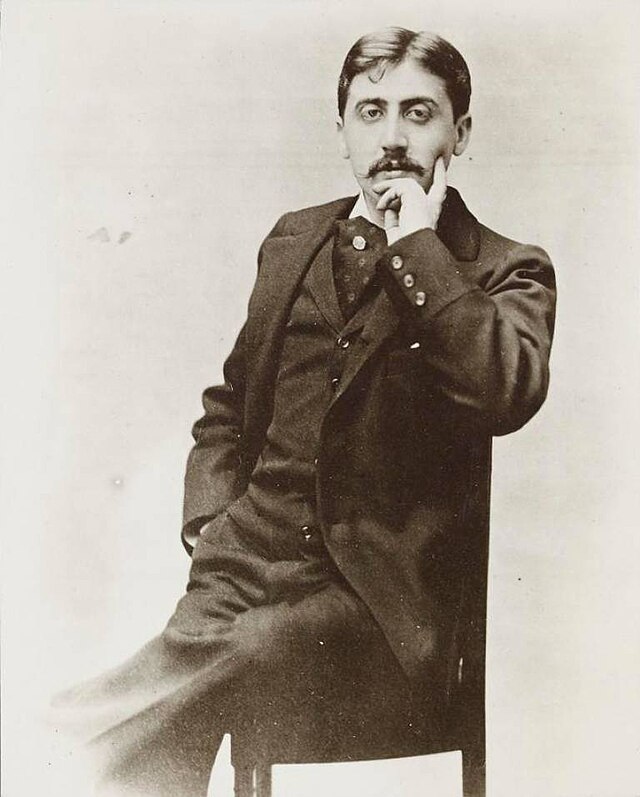Marcel Proust: Life and Works
Marcel Proust, who popped into the world on July 10, 1871, in Auteuil, Paris, wasn’t just any writer—oh no, he became a superstar in the world of French literature during the 20th century. People still tip their hats to him for digging deep into the tangled mess of time and memory, drawing on a treasure trove of personal experiences that give readers a peek into his world and mind.
Proust’s Literary Achievements
Here’s where Marcel proves he’s not just blowing smoke. His big-shot novel, A la recherche du temps perdu (often called In Search of Lost Time on this side of the pond), isn’t just a heavy hitter—it’s the heavyweight champ, at least according to folks at the Guinness World Records. This beast of a book, stretching across a mind-boggling 13 volumes and stacking up a whopping 9,609,000 characters, showcases Proust’s knack for unpacking the quirks of human nature and the relentless march of time. This epic has left its mark not only on French literature but has rippled across the world.
| Achievement | Description |
|---|---|
| Longest Novel | In Search of Lost Time bags the record as the longest novel, holding a special spot in the Guinness World Records. |
| Volume Count | An epic saga spread over 13 volumes. |
| Character Count | The whole shebang counts up to 9,609,000 characters. |
Proust’s Artistic Style
Proust doesn’t just string words together; he crafts an experience. His tales weave through intricate portraits and unique storytelling that dwell deep into human introspection. Proust had a knack for capturing the essence of human feelings and thoughts, using something he liked to call “involuntary memory.” It’s like when a smell or a taste pulls you down a rabbit hole of past moments, detailed beautifully in Le Temps retrouvé, the closing chapter of his grand series. Here, something simple jolts a cavalcade of memories, casting a spotlight on a vanished past.
He tangled his narratives with philosophical musings, taking readers on a trip of personal growth alongside the tale itself. His writing flows like a slow river, inviting folks to really chew over their own story and worldview. It strikes a note with anyone who loves a good book or holds a critic’s pen. Anyone itching to get under Proust’s skin should check out more on Proust philosophy and all those proustian themes he played with, for a deeper gulp of insight.
Notable Volumes of ‘In Search of Lost Time’
Marcel Proust’s epic creation, In Search of Lost Time, spans seven volumes, each giving a unique glance into life, love, and memory. Here’s a little peek into some standout volumes from this legendary series.
Volume 2: “In Search of Lost Time”
Here’s a fun fact—Proust’s second volume, also called In Search of Lost Time, snagged the prestigious Prix Goncourt in 1919, much to the joy of critics. It tracks the narrator’s tender affection for Gilberte Swann and his leisurely days at the dreamy beach of Balbec. This volume, with its captivating prose, was an instant hit with readers.
Volume 6: “Albertine disparue”
Albertine disparue hits all the emotional high notes of the series. It starts with the narrator coming to grips with Albertine fleeing, setting off a series of dramatic and tragic bits. In this volume, Proust lays out the deep philosophical ponderings that fans and critics rave about.
Volume 4: “Sodom and Gomorrha”
Volume 4, Sodom and Gomorrha, is a big deal in discussions around sexuality. Through raw portrayals of LGBTQ+ characters, it dives headfirst into themes of homosexuality and the narrator’s inner turmoil over Albertine’s possible interest in women.
Volume 7: “Finding Time Again”
Here’s the grand finale with Finding Time Again. It’s a dizzying mix of philosophical musings and concluding thoughts that, at times, read more like a course on living rather than a classic novel. The narrator reflects on art, imagines writing a killer book, and mingles with the old guard of Paris. This volume is a thought-provoking close to the whole shebang (French Literature For All).
Volume 3: “The Prisoner”
The Prisoner zooms in on the tense yet tender time when the narrator and Albertine live under one roof in Paris. Showcasing vibrant slices of Paris, this volume explores the wild ride of love, channeling the vibes of Baudelaire. It paints a vivid picture of how wonderfully complex and beautiful relationships can be, all while keeping up Proust’s reflective, poetic style.
These volumes dig into the heart of Proust’s exploration of time, love, and memory, serving as a treasure chest for book lovers craving quotes filled with Proustian wisdom (Proust quotes). If you want to dive deeper into the world of Proust, head over to our page on marcel proust novels for more musings and context.
The Proust Questionnaire
Where It All Began
Way back in 1886, fourteen-year-old Marcel Proust scribbled away answers for his buddy’s confession album—a book filled with questions about virtues, dreams, and whatnot (New Yorker). By the time Proust left this world in 1922, his answers, dusted off and published by André Berge in 1924, turned into the famous “le questionnaire de Proust.” This pretty much kicked off the whole Proust Questionnaire craze, transforming it into the big deal personality quiz it is today.
Why It Still Matters
Jump ahead to the ’90s and early 2000s, and everyone from Vanity Fair to your grandma’s book club was talking about the Proust Questionnaire. Vanity Fair snagged big names—Norman Mailer, Joan Didion, Karl Lagerfeld, Arnold Schwarzenegger, you name it—to fill it out (New Yorker). And let’s not forget how it took French TV by storm when Bernard Pivot added it to his program, “Apostrophes”, starting in 1975. Questions like “What’s your go-to curse word?” or “If God’s out there, what’s he saying to you posthumously?” made it a hit.
| Year | A Thing Happened |
|---|---|
| 1886 | Young Proust spills the beans in a questionnaire. |
| 1922 | The end of Proust’s journey. |
| 1924 | Our beloved Proust Questionnaire is born. |
| 1975 | French TV spins it into a showstopper. |
Sticking Around Today
Fast forward to now, and people are still nuts about the Proust Questionnaire. It’s like peeking into the lives of celebs—everyone’s curious about what makes the famous tick (New Yorker). As long as we’re nosy about folks’ private musings and inner worlds, the Proust magic isn’t going anywhere.
Want to dig into more Proust-y stuff? Check out some in-depth reads on his philosophy and dive into his novels for more mind-bending thoughts.
Exploring Proust’s Quotes
Marcel Proust’s words are like little treasure chests stuffed with wisdom, giving book lovers a peek into life’s big themes. His thoughts on seeing the world, dipping into memories, or the thrill of discovery pull you into what it means to be human. Let’s unpack some of his standout quotes and what they mean.
The Real Voyage of Discovery
One of Proust’s top hits is, “The real voyage of discovery consists not in seeking new landscapes, but in having new eyes.” Simply put, Proust thinks real breakthroughs happen when you change how you look at the world, not just by globetrotting. You’ll find this gem in his massive series “Remembrance of Things Past” (A.K.A In Search of Lost Time), particularly in volume 5, “The Prisoner”.
His narrator kicks around ideas about art and what different artists go through. Proust nudges at the idea of a “lost country,” hinting that having “other eyes” lets you soak up the world from fresh angles. This quote reminds us that the magic often lies in how we see, not just what we see.
Themes of Love and Memory
Proust loved diving deep into how love and memory tango together. For him, memory is a big player in how we live our lives. He often dives into how our past affects who we are, especially in the messiness of love. In Proust and memory, he suggests our memories of love are shaded by what we’re going through right now, showing how memories mix and twist with our feelings.
His take on love and memory makes readers ponder their life’s scrapbook and how it frames their love stories. He’s basically saying, if you wanna get love, you’ve got to dig around in your history, picking apart the tangled web of human dynamics.
The Portrait Analogy
Proust loves throwing in art metaphors to highlight what makes us tick as individuals. He saw each person as sharing their unique life story, much like a canvas capturing a scene. Picture an artist painting a subject’s true self. That’s every person, witnessing and reshaping their world through their history.
His deep insights get readers contemplating the crazy quilt of identity and nudges them to dive into Proustian characters, showing off the colorful human journey. Tapping into different perspectives can forge stronger links with others.
Proust’s quotes are packed not just with literary gold, but also with meaty reflections on life, love, and how we see things. These themes strike a chord with readers, proving how his insights stand the test of time. If you’re itching for more on his thinking, check out our pages on Proust philosophy and Proustian themes.
Recognition and Legacy
Guinness World Record
Marcel Proust’s heavyweight champ, In Search of Lost Time, owns the Guinness World Record for the longest novel ever penned. We’re talking 13 whopping volumes clocking in at around 9,609,000 characters. Pretty hardcore, huh? This biggie has had a serious hand in shaping 20th-century French lit and is still a big deal across the globe.
| Record | Detail |
|---|---|
| Title | A la recherche du temps perdu |
| Volume Count | 13 |
| Total Characters | 9,609,000 |
Connection with Readers
Proust is like the DJ of time and memory, spinning tales that hit home with folks like us. His way of hooking readers with everyday moments and emotions is uncanny. You read his stuff, and suddenly you’re walking in his characters’ shoes, nodding along to their journeys. If you’re ever skimming through Proust quotes, you’ll stumble upon nuggets on love and life that still pack a punch today (My French Life).
Critical Works and Biographical Information
Proust didn’t just stop at novels; he gave us gems like Journées de lecture, which feels like a cozy chat about the magic of reading. Imagine him chatting about his literary escapades and how each book left its mark on him—bookworms totally dig it (My French Life). For those itching for more Proust vibes, check out Marcel Proust biography and see how his ideas breathe life into Proust philosophy.
Checking out Proust’s legacy means diving into a pool of creativity and mind-boggling insights. The themes he weaves into his stories, like Proustian themes and Proustian characters, still get the brain gears turning in today’s lit circles and Proust studies.

